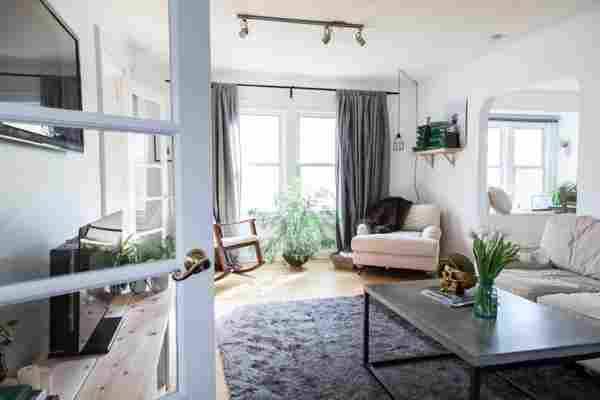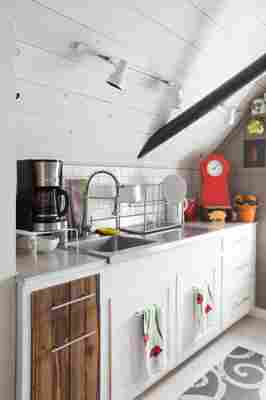
I don’t know about you, but when I hear “track lighting,” I picture a sad ’80s sitcom bachelor pad. But what do I know? Even the most precision-dated trends can make a comeback once nostalgia gets the best of us. Denim jackets, leg warmers, big blazers — all have seen a resurgence in the past few years. I’ve even heard teenagers singing Phil Collins without irony.

So is track lighting due for its own retro revival, helped by the popularity of industrial interiors and a DIY simplicity that never goes out of style? Or is it best left in the attic of ’80s history with VHS tapes and parachute pants?
One thing working in its favor: The DIY usefulness of track lighting can’t be denied. By allowing you to turn one electrical box into several light fixtures — positioned and pointed wherever you want them — track lighting is essentially the extension cord or power strip of interior illumination.
A track lighting kit allows you anchor everything into a single electrical box, from which current runs along an exterior track or rail. You can connect additional lamp heads in any configuration you want. That makes track lighting an easy way to brighten up a space or add a lot of lights without opening up walls or rewiring anything — handy for novice DIYers or renters.
But, like an extension cord, it doesn’t always look seamless or natural.
“I have track lighting in my kitchen,” says DIY blogger Sarah Fogle of The Ugly Duckling House . “Truthfully, it really isn’t my favorite aesthetically, so I chose a fixture that hugged close to and in the same color as the ceiling,” she adds.
Fogle had only one light fixture placement in the kitchen ceiling — and in her early days of DIY, she wasn’t prepared to make more holes in the ceiling or run any extra wiring. “Track lighting helped me to add tons more light all over the room with a single install,” she says. “As long as you can keep it low-profile, it’s a great option when you need lots more light and aren’t willing — or able, such as in a rental — to add more fixtures.”
Jenn Largesse, creator of the design and DIY site House One , says track lighting really only works with certain styles. “In an industrial or more modern space, it can be done tastefully,” Largesse says. But in other settings, “It can look out of place or make the ceiling look busy or cluttered,” she adds.
“It’s really a better solution to layer floor lamps or pendants and chandeliers, to create different layers of light instead of having these pointed things hangings from your ceiling,” Largesse says. But it can be a great DIY solution in terms of the ease of installation, she adds.
If you do need to use track lighting, whether because you can’t get into the ceiling or you don’t have space for recessed lighting, Largesse says, “Use the track to hang pendant style lighting, so you’re drawing people’s eyes away from the track and to the fixtures themselves. You never want the track to be the focal point.”
And if it’s task lighting you’re after, Largesse recommends looking into under-cabinet options. “If you’re in a kitchen and you want task lighting around the counters, I think under-cabinet lighting is a more unobtrusive a way to quietly light those areas without it being a focal point,” she says.
As with any reboot, track lighting has received some modern updates. Flexible, low-voltage rail lighting, sometimes called monorail, can be more expensive and requires a transformer , but is also easy to install and a lot cleaner looking. Newer track lighting designs, meanwhile, can give off a more classic look than you might expect, or even dangle exposed Edison-bulb pendants, like you might see in a favorite rustic restaurant.
You can buy track lighting in a single kit, or buy lengths of track or rail and lamps or pendants separately; if you take the latter approach, just keep in mind that different manufacturers don’t play well together — but you can mix and match (and later swap out) the lamp heads to your heart’s content, as long as they’re in the same product line.
That versatility and the ability to change your mind without having to plug holes in the ceiling is one reason track and rail lighting remains popular. Largesse notes that track lighting still sells surprisingly well. “It’s unbelievable how many people are purchasing track lighting, so there’s still a market for it,” she says, for better or worse.
While I’m in no way comparing track lighting to the brilliance of The Joshua Tree, it’s clear there’s a market for just about everything ’80s. U2’s in-concert celebration of its 1987 masterpiece was the top-grossing tour of 2017 , earning $316 million; ’80s New Wave icons Depeche Mode logged the sixth highest grossing tour, with $141 million in revenue.
And when you think about it, those concert spotlights look a lot like track lighting, don’t they?
